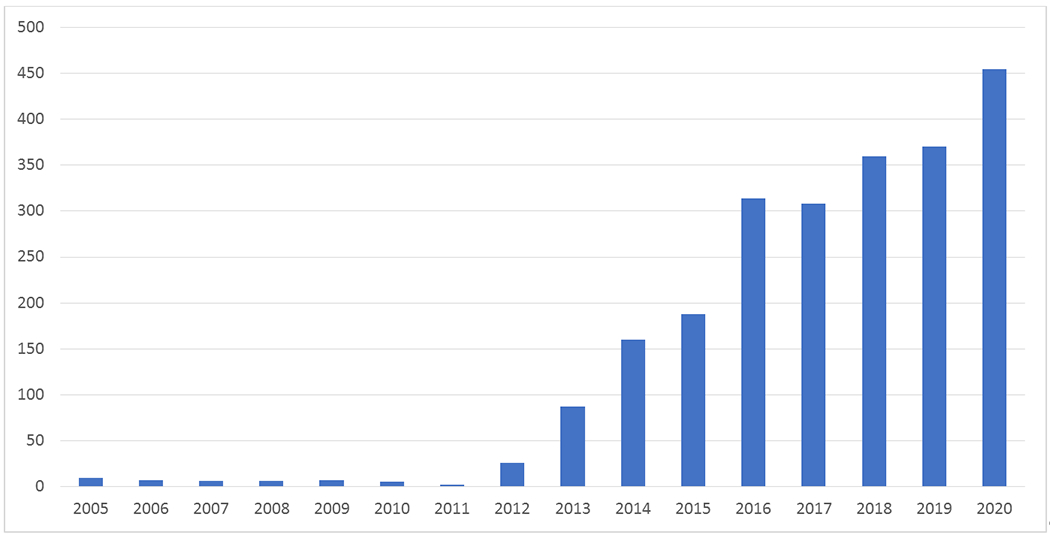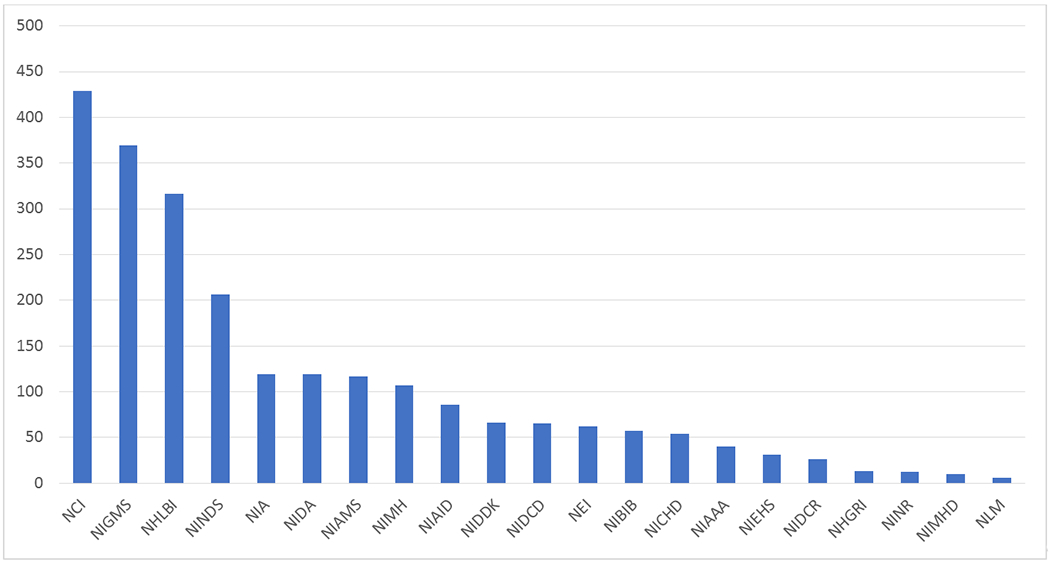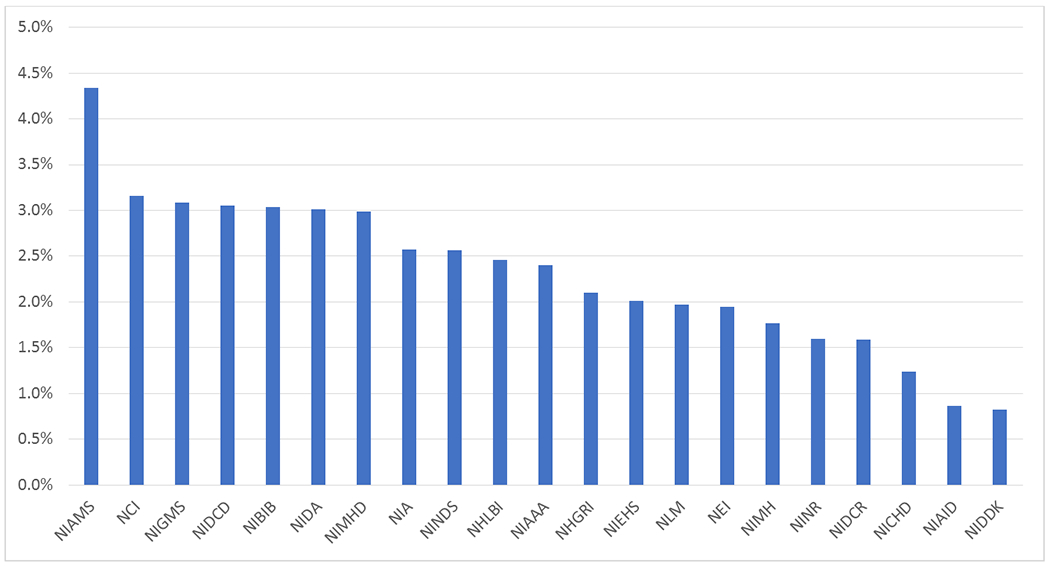The National Institutes of Health (NIH) and the United States Congress have cited the lack of diversity in the biomedical workforce as a serious concern.1,2 In 2020, only 2% and 5% of NIH R01 grants were awarded to Black and Latinx scientists, respectively.3 To help address this issue, in 1989, NIH introduced diversity supplements,1 which award additional funding to existing grants whereby a principal investigator can provide research opportunities, training, and mentorship to an individual underrepresented in research at any career stage.2 Diversity supplements are offered by every NIH institute and are available for most research and program/project center grants.2
Despite the potential of diversity supplements to bolster diversity in biomedicine, there is little information to understand the extent to which these supplements have been utilized and whether utilization has changed over time.
Methods
To investigate recent trends in their use, we analyzed diversity supplements administered by NIH institutes from 2005-2020. We examined supplements associated with R01 grants, as R01s have been eligible for diversity supplements since the program’s introduction and are the most common NIH investigator-initiated research project mechanism.
We determined the number of diversity supplements by fiscal year, administering NIH institute, and principal investigator using the public NIH RePORTER tool. We calculated the annual growth rate for the number of diversity supplements. Supplements were included in the fiscal year in which they were awarded. Analyses were performed using R version 4.1.1 and RStudio. The Yale Institutional Review Board deemed this study exempt.
Results
From 2005-2010, few diversity supplements were awarded (Figure 1). From 2011-2020, the number of new R01-associated diversity supplements grew from two to 455, representing an annual growth rate of 82.8%. From 2005 to 2020, NIH institutes funded 93,285 R01 grants, of which 2,145 (2.3%) received at least one diversity supplement and 149 (0.16%) received two or more supplements. Since 2005, there have been 2,084 principal investigators who received R01-associated diversity supplements; 67 (3.2%) received two supplements for distinct R01 grants, eight (0.38%) received three, and one (0.05%) received four.
Figure 1:

Number of new R01-associated diversity supplements by fiscal year.
Since 2005, National Cancer Institute awarded the highest number of diversity supplements (n = 429, R01 grants with supplement = 3.2%) and National Institute of Arthritis and Musculoskeletal and Skin Diseases administered the highest percentage (4.3%, n = 117) of R01 grants with a diversity supplement; National Library of Medicine awarded the lowest number (6, 2.0%) and National Institute of Diabetes and Digestive and Kidney Diseases administered the lowest percentage (0.83%, n = 66; Figure 2).
Figure 2.


a: Number of new R01-associated diversity supplements from 2005-2020 by administering NIH institute. From left to right: (NCI) National Cancer Institute; (NIGMS) National Institute of General Medical Sciences; (NHLBI) National Heart, Lung, and Blood Institute; (NINDS) National Institute of Neurological Disorders and Stroke; (NIA) National Institute on Aging; (NIDA) National Institute on Drug Abuse; (NIAMS) National Institute of Arthritis and Musculoskeletal and Skin Diseases; (NIMH) National Institute of Mental Health; (NIAID) National Institute of Allergy and Infectious Diseases; (NIDDK) National Institute of Diabetes and Digestive and Kidney Diseases; (NIDCD) National Institute on Deafness and Other Communication Disorders; (NEI) National Eye Institute; (NIBIB) National Institute of Biomedical Imaging and Bioengineering; (NICHD) National Institute of Child Health and Human Development; (NIAAA) National Institute on Alcohol Abuse and Alcoholism; (NIEHS) National Institute of Environmental Health Sciences; (NIDCR) National Institute of Dental and Craniofacial Research; (NHGRI) National Human Genome Research Institute; (NINR) National Institute of Nursing Research; (NIMHD) National Institute on Minority Health and Health Disparities; (NLM) National Library of Medicine.
b: Percentage of R01 grants with a diversity supplement from 2005-2020 by administering NIH institute. From left to right: (NIAMS) National Institute of Arthritis and Musculoskeletal and Skin Diseases; (NCI) National Cancer Institute; (NIGMS) National Institute of General Medical Sciences; (NIDCD) National Institute on Deafness and Other Communication Disorders; (NIBIB) National Institute of Biomedical Imaging and Bioengineering; (NIDA) National Institute on Drug Abuse; (NIMHD) National Institute on Minority Health and Health Disparities; (NIA) National Institute on Aging; (NINDS) National Institute of Neurological Disorders and Stroke; (NHLBI) National Heart, Lung, and Blood Institute; (NIAAA) National Institute on Alcohol Abuse and Alcoholism; (NHGRI) National Human Genome Research Institute; (NIEHS) National Institute of Environmental Health Sciences; (NLM) National Library of Medicine; (NEI) National Eye Institute; (NIMH) National Institute of Mental Health; (NINR) National Institute of Nursing Research; (NIDCR) National Institute of Dental and Craniofacial Research; (NICHD) National Institute of Child Health and Human Development; (NIAID) National Institute of Allergy and Infectious Diseases; (NIDDK) National Institute of Diabetes and Digestive and Kidney Diseases.
Discussion
Between 2005 and 2020, the number of diversity supplements increased, with variation across NIH institutes. This growth coincided with a period of heightened awareness concerning a lack of diversity in the biomedical workforce as demonstrated by a study by Ginther et al.4 highlighting racial disparities in NIH funding (2011), a report from NIH5 investigating diversity in the biomedical research workforce (2012), and the appointment of NIH’s inaugural Chief Officer for Scientific Workforce Diversity (2014).
Nevertheless, in 2020 only 4.5% of active R01 grants had ever received a diversity supplement. This suggests diversity supplements remain an infrequently awarded tool to promote diversity in the biomedical workforce.
This study is limited by the unavailability of data by NIH institute detailing the number of applications received, budget reserved for, duration of, and career stage of recipients of diversity supplements. Although over 70% of diversity supplements listed in the NIH RePORTER database are associated with R01 grants, some institutes may have awarded diversity supplements to grant types not accounted for in this study.2
Diversity supplements have the potential to increase representation of historically underrepresented groups in research. Yet many researchers report limited knowledge about the diversity supplement program.6 Future opportunities for programmatic growth include increasing diversity supplement program awareness and expanding NIH funding.
Funding/Support:
This publication was made possible by the Richard K. Gershon, M.D. Fund at Yale University School of Medicine and the National Institute of General Medical Sciences under Award Number R01GM137411.
Role of the Sponsor:
The Richard K. Gershon, M.D. Fund at Yale University School of Medicine and The National Institute of General Medical Sciences had no substantive involvement in the design and conduct of the study; collection, management, analysis, and interpretation of the data; preparation, review, or approval of the manuscript; and decision to submit the manuscript for publication. The content is solely the responsibility of the authors and does not necessarily represent the official views of the National Institutes of Health.
Footnotes
Financial Disclosures: None reported
References
- 1.National Institutes of Health. Initiatives for underrepresented minorities in biomedical research. Accessed September 18, 2021. https://grants.nih.gov/grants/guide/historical/1989_04_21_Vol_18_No_14.pdf
- 2.National Institutes of Health. Research Supplements to Promote Diversity in Health-Related Research. Accessed September 18, 2021. https://grants.nih.gov/grants/guide/pa-files/pa-20-222.html
- 3.National Institutes of Health. Racial disparities in NIH funding. Accessed September 18, 2021. https://diversity.nih.gov/building-evidence/racial-disparities-nih-funding
- 4.Ginther DK, Schaffer WT, Schnell J, et al. Race, ethnicity, and NIH research awards. Science. August 19 2011;333(6045):1015–9. doi: 10.1126/science.1196783 [DOI] [PMC free article] [PubMed] [Google Scholar]
- 5.Advisory Committee to the Director Working Group on Diversity in the Biomedical Research Workforce. Draft Report of the Advisory Committee to the Director Working Group on Diversity in the Biomedical Research Workforce. National Institutes of Health. Accessed September 18, 2021. https://acd.od.nih.gov/documents/reports/DiversityBiomedicalResearchWorkforceReport.pdf [Google Scholar]
- 6.Preis SR, Sarfaty SC, Tepperberg S, Torres A, Walkey A. NIH Diversity Supplements at BU. Boston University. Accessed September 18, 2021. https://www.bumc.bu.edu/facdev-medicine/files/2020/05/NIH-Diversity-Supplement-Presentation.pdf [Google Scholar]


